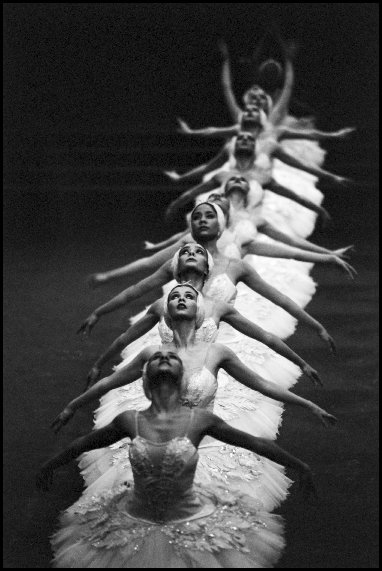ROBERT McFARLANE, SWAN LAKE
Gael Newton 2006
2017 version of an article originally published Antiques & Art, August 2006
Robert McFarlane is best known to the public as the photography critic for the Sydney Morning Herald.
However in the film and theatre world he is recognised as a major photographer with extraordinary interpretive skills.
McFarlane brings his reportage skills to the demanding task of still photography when the effect of spontaneity must be enacted for the camera or captured during a live performance.
While his work stands as a visual record of tumultuous decades in Australian culture and political life, he has achieved this not so much as a documentary journalist but more subtly through the portrayal of individuals.
His hallmarks of mysterious tonality, the isolation of a figure within a group and their relation to the surrounding space are epitomised in the corps de ballet picture Swan Lake recently acquired for the National Gallery of Australia (NGA).
McFarlane's future as a photographer was marked out at fourteen when he shot his first 'decisive moment,' of the headmaster hitting a student in assembly. Leaving school at sixteen he worked in a variety of jobs in Adelaide. |
|
 |
Robert McFarlane (Australia 1942-), Swan Lake, corps de ballet,
Sydney Entertainment Centre, 1999. 37.2 x 25.0 cm.
Gelatin silver photograph. National Gallery of Australia |
The defining moment in his choice of career was seeing the blockbuster Family of Man, a travelling photojournalism exhibition from the Museum of Modern Art, New York, shown at the Myers store in Adelaide in 1959. It showed him the power of photography and sealed his lifelong interest in the human condition.
While working for McCallum Richardson, a small advertising agency in Adelaide, McFarlane's passion for photography was taken seriously and encouraged. He moved to Sydney in 1963 where he began freelancing for national magazines including The Bulletin, Vogue Australia and Walkabout. His first major exposure came in People in 1966 and about this time he became interested in fringe theatre.
Over the next six years he continued to freelance while editing the national photography magazine Camera World. His career as a photography journalist and critic has continued to the present. In 1969 McFarlane travelled overland through Asia to Europe and London. He freelanced for the Telegraph Magazine and later for the Sunday Times Colour Magazine and NOVA.
In 1973 McFarlane returned to Australia and has since focused on documenting social issues, theatre and film.
McFarlane shot the picture of Swan Lake on an assignment in 1999 from The Bulletin to make a photo essay on an Australian who was a principal dancer with the Scottish National Ballet on tour in Australia. He has described the creation of the photograph:
'I arrived at the Sydney Entertainment Centre just as a rehearsal was starting on a bare stage, lit by little more than work lights. Gradually this increased slightly and I started to believe I might be able to make some pictures.
Luckily I had brought a small tripod and a camera with a long, fast lens. With this combination I reasoned I might just be able to contain the dancers' movement in an image of somewhat compressed perspective (at the slow shutter speed dictated by the light).
I had been struck by the impressive entrance made by the corps de ballet. (I have this rather fragile theory that we all respond to repetition of form—I think it suggests abundance to the unconscious—it's just a theory, however).
When I looked at the line of dancers through the lens at 200 mm I was surprised at how stressed their faces were. No one works harder that ballet dancers and this was a key to the picture's emotion, I suppose.'
This image was so successful that The Bulletin ran it as a full page within the body of the photo-essay.
The National Gallery of Australia (NGA) acquired Swan Lake since it illustrates McFarlane's empathy with theatre and film. It also relates well to the holdings of ballet photographs in the collection. The 1960s has in general had less attention from scholars and curators of photography than earlier decades and over the past few years the NGA has concentrated on improving its holdings for that era.
A recent archive review of McFarlane's work made hundreds of images available and the extent and power of McFarlane's reportage of the sixties and seventies was revealed. The NGA has also acquired a group of works representing McFarlane's early career and his long standing interest in Anzac Day ceremonies and the preoccupations of an older generation of Australians.
The NGA is currently focusing its resources on improving its collections of early nineteenth-century forms of photography as well as mid-century 'new photography' modernist works. In the contemporary area the gallery is acquiring recent works by established senior and mid-career artists as well as by emerging artists not previously represented.
Artists and styles are constantly being reassessed and new research leads curators to seek out overlooked or lesser-known artists to fill gaps in the existing holdings.
More about Robert McFarlane
more of Gael Newton's Essays and Articles
|